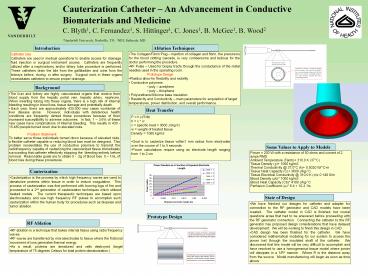Cauterization Catheter - PowerPoint PPT Presentation
1 / 1
Title:
Cauterization Catheter
Description:
Cauterization Catheter An Advancement in Conductive Biomaterials and Medicine C. Blyth1, C. Fernandez1, S. Hittinger1, C. Jones1, B. McGee1, B. Wood2 – PowerPoint PPT presentation
Number of Views:30
Avg rating:3.0/5.0
Title: Cauterization Catheter
1
Cauterization Catheter An Advancement in
Conductive Biomaterials and Medicine C. Blyth1,
C. Fernandez1, S. Hittinger1, C. Jones1, B.
McGee1, B. Wood2 1Vanderbilt University,
Nashville, TN 2NIH, Bethesda, MD
Introduction
Ablation Techniques
- The Collagen/Fibrin Plug Injection of collagen
and fibrin, the precursors for the blood clotting
cascade, is very cumbersome and tedious for the
doctor performing the procedure. - RF Pulse Used for biopsy tracts through the
conductance of the metal needles used in the
operating room. - Prototype Design
- Plastics allow for flexibility and mobility
- Conductive polymers
- poly acetylene
- poly thiophene
- Polyurethane/Silicone base insulation
- Resistivity and Conductivity main parameters
for acquisition of target temperatures, power
distribution, and overall performance.
Catheter Use Catheters are used in medical
operations to enable access for drainage, fluid
injection or surgical instrument access.
Catheters are frequently utilized after a
nephrostomy and/or biliary tube procedure is
performed. These catheters drain the bile from
the gallbladder and urine from the kidneys
before, during, or after surgery. Surgical work
in these organs necessitates catheters to ensure
proper drainage.
Background
- The liver and kidney are highly vascularized
organs that receive their blood supply from the
hepatic portal vein, hepatic artery, nephrons.
When inserting tubing into these organs, there is
a high risk of internal bleeding resulting in
blood loss, tissue damage and potentially death. - Each year, there are approximately 430,000 new
cases worldwide of liver disease alone. However,
individuals with deleterious health conditions
are frequently denied these procedures because of
their increased susceptibility to adverse
outcomes. In fact, 1 3.6 of these new cases
have complications of internal bleeding. This
results in 430 - 15,480 people turned down due to
elevated risks. - Problem Statement
- To better serve those individuals turned down
because of elevated risks, a flexible catheter
capable or reducing blood loss most be designed.
This problem necessitates the use of conductive
polymers to transmit the radiofrequency capable
of cauterizing the vascularized tissue
immediately surrounding that catheter effectively
stopping the bleeding entirely before removal.
Reasonable goals are to obtain 0 - .2g of blood
loss 0 1mL of blood loss during these
procedures.
Heat Transfer
- P h (dT/dt)
- h c w
- c specific heat 3600 J/(kg K)
- w weight of treated tissue
- Density 1060 kg/m3
- Goal is to cauterize tissue within1 mm radius
from electrodes over the course of 1 to 5 seconds - Power calculations require using an electrode
length ranging from 1 to 2 cm
Some Values to Apply to Models
Power 200 W with a resistance of 50 ohms and
current of 2 amps RMS Ambient Temperature (Tamb)
310.0 K (37C) Tissue Density (?) 1060
kg/m3 Thermal Conductivity _at_ 37.0C (k) 0.5020
W/C-m Tissue Heat Capacity (C) 3600
J/kg-C Tissue Electrical Conductivity _at_ 310.0 K
(s)x 0.148 S/m Blood Density (?b) 1000
kg/m3 Blood Heat Capacity (Cb) 4180
J/kg-C Perfusion Coefficient (?) 6.4 10-3 1/s
State of Design
- We have finished our designs for catheter and
adapter for connection to the RF generator and
CAD models have been created. The catheter model
in CAD is finished, but crucial questions arose
that had to be answered before proceeding with
the RF generator connection. Connecting the
catheter to the RF generator has proposed design
considerations that have delayed development. We
will be working to finish this design in CAD. - CAD design has been finished for the catheter.
We have considered mathematical modeling for our
system to access the power lost through the
insulated shaft of the catheter. We discovered
that this model will be very difficult to
accomplish and have resolved to use a homogeneous
tissue model where power will dissipate in a 1/R2
manner. Where R is the distance away from the
source. Model manufacturing will begin as soon
as time allows.
Prototype Design
RF Ablation
- RF ablation is a technique that bakes internal
tissue using radio frequency waves. - RF waves are transferred by microelectrodes to
tissue where the frictional movement of ions
generates thermal energy. - As a result, proteins are denatured and cells
destroyed (target temperature of 75 degrees
Celsius for total protein denaturization.)































